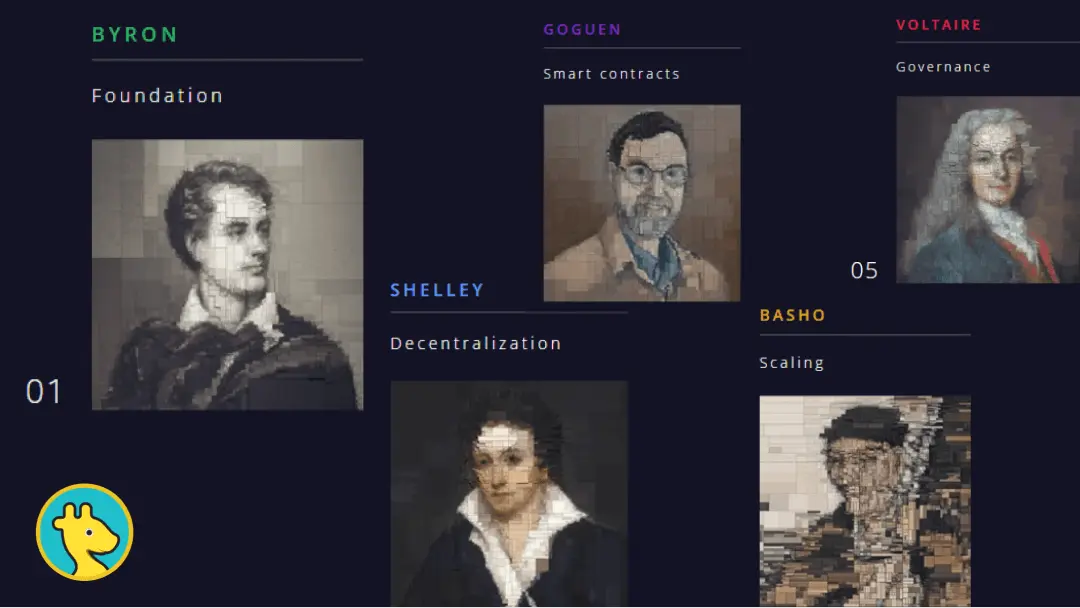From Byron to Basho: The Evolutionary Journey of Cardano's Development Phases
![]() Sarah Rodriguez • 23 Oct 2023
Sarah Rodriguez • 23 Oct 2023

The cryptocurrency realm has witnessed countless projects emerge with promises to redefine the future. Yet, few have approached their vision with the same methodical, research-driven perspective as Cardano. Recognized as a pioneering third-generation blockchain, Cardano's genesis isn't a mere spur-of-the-moment endeavor. It's a strategically mapped journey delineated into distinct developmental phases, each designed to bolster the platform's reliability, utility, and foresight.
Cardano's inception brought forth a unique blend of academic rigor, peer-reviewed research, and a commitment to creating a decentralized ecosystem that's truly sustainable. Behind this commitment lies a series of planned developmental phases. Each phase, from Byron to Basho, serves as a milestone marking Cardano's evolutionary leap in the blockchain arena.
In this article, we'll delve deep into:
- Byron: Setting the foundational stone.
- Shelley: Breathing life into decentralization.
- Goguen: Unleashing the potential of smart contracts.
- Basho: Scaling the system for a global audience.
- Voltaire: Steering Cardano with decentralized governance.
Embracing a chapter-like approach, we invite you on this explorative journey, starting with the foundational phase, Byron. Ready to dive in?
The Birth of Byron: Foundations
In the vast ocean of cryptocurrencies, every project has its origin, its "genesis block" moment. For Cardano, this moment was encapsulated in the Byron phase. It wasn't just about launching another cryptocurrency but laying a rock-solid foundation upon which an architectural marvel would rise.
Byron was all about bootstrapping the network. Think of it as the laying of the first brick, ensuring that everything is level, stable, and ready to support the weight of what's to come. It was during this phase that the ADA cryptocurrency was birthed, serving as the lifeblood of the Cardano network.
Key accomplishments of the Byron phase included:
- Secure Bootstrapping: Ensuring that the network started with robust security measures, mitigating potential vulnerabilities from the outset.
- ADA Launch: Introducing Cardano's native cryptocurrency, ADA, which would play a pivotal role in the platform's staking, governance, and utility.
- Basic Transactional Capabilities: Establishing a system where ADA could be transferred, ensuring the fundamentals of crypto transactions were in place.
Furthermore, the Byron era saw the development of the Daedalus wallet, Cardano's official desktop wallet, designed to safely store ADA. This wasn't just another digital wallet; Daedalus represented Cardano's commitment to user sovereignty, allowing users to have full control over their cryptographic keys.
At its core, the Byron phase wasn't about flamboyance. It was a testament to Cardano's belief in starting right. By ensuring that the network's initial launch was secure, stable, and reliable, Cardano set the stage for the more complex and transformative phases that lay ahead.
For those curious about the technology driving Cardano's early days, the Ouroboros Classic protocol was the powerhouse behind Byron, representing one of the first provably secure proof-of-stake algorithms in the crypto sphere.
Shelley: The Dawn of Decentralization
As the sun rises after the darkest night, so did Cardano with its transition from Byron to Shelley. While Byron was about establishing a secure foundation, Shelley's mission was audacious: to achieve full decentralization without compromising security or stability.

Decentralization isn't merely a buzzword for Cardano; it's the very essence of its vision. Shelley aimed to transfer the power once held by the core network to the community, ensuring that Cardano's heartbeat would resonate with the pulses of its stakeholders.
During the Shelley phase, significant strides were made:
- Decentralized Block Production: Shelley ushered in an era where blocks on the Cardano blockchain were produced not just by a central entity but by the community, via various stake pools.
- Staking and Delegation: ADA holders could now participate actively in the network. By staking their ADA or delegating it to stake pools, they played a part in block production and earned rewards in return.
- Rewards System: To incentivize participation, Cardano introduced a rewards system. The more ADA you staked or delegated, the higher your potential rewards, fostering a vibrant and engaged community.
The beauty of Shelley wasn't just in its technical advancements but in its philosophy. By empowering ADA holders and ensuring that power dynamics were not concentrated, Cardano took a giant leap towards becoming a truly decentralized and democratic platform.
The beauty of Shelley wasn't just in its technical advancements but in its philosophy. By empowering ADA holders and ensuring that power dynamics were not concentrated, Cardano took a giant leap towards becoming a truly decentralized and democratic platform.
For enthusiasts keen on the intricacies of Shelley's implementation, the Cardano Improvement Proposals (CIPs) offer an in-depth look into the various improvements and innovations introduced during this phase.
Goguen: Unlocking Smart Contracts
If Shelley represented the dawn of decentralization, Goguen was the high noon, illuminating the vast potential landscape of Cardano's smart contract capabilities. In a world increasingly becoming interconnected, smart contracts act as the digital glue, automating and securing transactions without intermediaries.
Basho: Scaling New Heights
When discussing blockchains, scalability is the proverbial elephant in the room. As platforms grow in adoption, so does the strain on their systems. Basho represents Cardano's response to this challenge, a phase dedicated to enhancing performance, resilience, and scalability.
A Necessity for Global Adoption
For blockchain technologies to truly shine on the global stage, they must handle vast amounts of data and transactions without faltering. Basho's inception wasn't just a choice—it was an imperative for Cardano's vision of global utility.
Enter Hydra: Cardano's Scalability Solution
Hydra is Cardano's answer to layer-2 scaling. Rather than altering the base layer, which might compromise security or decentralization, Hydra operates atop it, exponentially increasing transaction throughput. With every user or "head" added, Hydra's processing capability grows, making scalability virtually limitless.
Sidechains and Interoperability
In the vast world of blockchains, no platform is an island. Basho introduces sidechains, secondary blockchains that run parallel to the main chain. These aren't mere offshoots—they're integral to ensuring Cardano can seamlessly interact with other platforms, amplifying the concept of blockchain interoperability.
Sidechains play dual roles:
- Offloading Processing: By handling certain transactions, they alleviate the load on the main chain, enhancing performance.
- Interacting with Other Platforms: Sidechains act as bridges, enabling Cardano to communicate and transact with other blockchains.
A Future-Proofing Philosophy
Basho's emphasis isn't solely on addressing present challenges. It's a testament to Cardano's foresight, anticipating future scalability needs and ensuring the platform remains agile, resilient, and adaptable.
For those intrigued by the intricacies of Basho's technological underpinnings, diving into Cardano's official documentation provides a comprehensive look into its visionary approach to scalability.

Goguen's goal was audacious: not just to implement smart contracts, but to refine, revolutionize, and expand their capabilities, making them more accessible, secure, and efficient. This wasn't merely an iteration; it was a reimagining.
Key milestones achieved during the Goguen phase:
- Plutus Platform: A unique platform that brought the power of Haskell-based scripting to blockchain. With Plutus, developers could craft robust and reliable smart contracts.
- Marlowe: Cardano didn’t stop with just one smart contract platform. Marlowe provided financial contract support, designed for those without a programming background. Its intuitive, block-based interface democratized the creation of secure financial smart contracts.
- Multi-Currency Support: Beyond just ADA, Goguen introduced native token support, allowing users to create their own tokens on the Cardano blockchain, a major step towards fostering a multifaceted digital economy.
But what truly set Goguen apart was its commitment to inclusivity. Recognizing that the future of blockchain lay not just in the hands of seasoned developers but everyday enthusiasts, tools and platforms were crafted with accessibility in mind. With Goguen, Cardano sent a clear message: everyone is invited to this revolution.
To understand the deeper mechanics of how Cardano's smart contract functionality differentiates itself, a dive into the Extended UTXO model provides enlightening insights, showcasing a blend of innovation and practicality.
For a more granular understanding of Goguen's nuances, the Cardano Development Portal is a treasure trove of resources, tutorials, and in-depth explorations.
Voltaire: Decentralized Governance Takes Center Stage
In the dynamic realm of blockchain, technological prowess alone doesn't ensure longevity. A system's ability to adapt, evolve, and refine its goals is pivotal. Voltaire symbolizes this ethos for Cardano, ushering in a new era of decentralized governance and community-driven decision-making.
Catalyst: The Heartbeat of Cardano's Governance
Every democratic system needs a mechanism to facilitate, process, and implement collective decisions. Project Catalyst stands as Cardano's foundational tool in this domain, acting as a bridge between the community's aspirations and the platform's developmental trajectory.
How Catalyst Works
At its core, Catalyst encourages ADA holders to propose, discuss, and vote on potential developments or changes to the Cardano ecosystem. This iterative process involves:
- Proposal Submission: Community members can submit their ideas and projects for review.
- Discussion & Feedback: These proposals undergo scrutiny, debate, and refinement by the community.
- Voting: ADA holders, based on their stake, cast their votes, deciding which proposals receive funding or implementation.
Treasury System: Fueling Future Innovations
While visions and ideas are invaluable, bringing them to fruition requires resources. Voltaire introduced a unique treasury system, ensuring that Cardano remains self-sustaining. A portion of transaction fees and staking rewards flows into this treasury, financing approved projects and initiatives.
Ensuring Transparency & Integrity
To guarantee the rightful use of treasury funds, all financed projects undergo stringent monitoring. Reports, updates, and results are shared with the community, maintaining a transparent and accountable ecosystem.
Pioneering a Truly Democratic Ecosystem
Voltaire isn't just about mechanisms and systems; it's a reflection of Cardano's belief in collective wisdom. By empowering its community to have a genuine say in its direction, Cardano exemplifies a new age of decentralized democracy in the blockchain realm.
For readers keen on delving deeper into the nuances of Voltaire's governance model, a thorough exploration on Cardano's governance portal offers enlightening insights.
Interoperability: Bridging the Blockchain Divide
Amidst the sprawling landscape of blockchain technologies, one of the most pressing challenges is fostering communication between distinct blockchain platforms. For Cardano, this isn't just a technical hurdle but a fundamental tenet of its vision. As we delve into Cardano's strides towards interoperability, we explore how it's pioneering a unified, cohesive digital future.

Beyond the Siloed Ecosystems
Historically, blockchains have functioned as isolated islands, each with its unique protocols and standards. Such isolation hinders the broader adoption and functionality of decentralized technologies. Cardano recognizes that for blockchains to realize their full potential, these islands need bridges.
The Complexity of Cross-Chain Communication
Bridging different blockchains isn't merely about facilitating token transfers. It's about understanding and translating different consensus mechanisms, security protocols, and transaction formats. This complexity underscores the significance of Cardano's interoperability pursuits.
Cardano's Approach: Seamless & Secure Integration
Cardano doesn't adopt a one-size-fits-all approach. Instead, it emphasizes bespoke solutions tailored to individual blockchains while ensuring a seamless user experience.
- Cross-Chain Transfers: Allowing assets from one blockchain to be utilized or represented on Cardano and vice versa. If you're interested in exchanging Cardano with different cryptocurrencies, you can easily Exchange Cardano on our service.
- Metadata Interchange: Enabling different blockchains to understand and interpret transaction data, ensuring consistency and coherence.
- Shared Security Models: Proposing shared security mechanisms, ensuring that assets moving across chains maintain their integrity and security.
FAQ
What is Cardano?
Cardano is a third-generation blockchain platform aimed at creating a more secure and scalable decentralized system. Its unique layered architecture separates the settlement layer from the computation layer, enabling smart contracts and applications to run without affecting the performance of transactions.
How many development phases does Cardano have?
Cardano's roadmap is divided into five major phases: Byron, Shelley, Goguen, Basho, and Voltaire. Each phase focuses on specific enhancements, from foundational operations to scalability and governance.
What makes Cardano different from other blockchains like Ethereum or Bitcoin?
Cardano's focus on peer-reviewed scientific research, its layered architecture, and its commitment to sustainability and governance set it apart. While Bitcoin emphasizes decentralized transactions and Ethereum on smart contracts, Cardano aims to combine these features with scalability and interoperability solutions.
Is Cardano's approach to scalability different from other blockchains?
Yes, in the Basho phase, Cardano introduces solutions like Hydra, a layer-2 scaling solution. Hydra enhances transaction throughput by adding more "heads" or users, making the system potentially limitless in terms of scalability.
What are sidechains in the context of Cardano?
In the Basho phase, Cardano introduces sidechains, which are parallel blockchains to the main chain. These allow Cardano to offload certain transactions, improving performance, and also act as bridges for Cardano to interact with other blockchain platforms.
Where can I learn more about Cardano's technological details and updates?
Cardano's official website and their detailed documentation provide in-depth insights into its technology, research papers, and updates. Additionally, the Cardano community forums and discussion groups offer real-time discussions and expert opinions.
How can I exchange Cardano with other cryptocurrencies?
You can easily exchange Cardano with a myriad of other cryptocurrencies on our Exchange Cardano platform. Follow the guided steps to facilitate a seamless trading experience.
Is Cardano eco-friendly?
Yes, Cardano uses a Proof-of-Stake (PoS) consensus mechanism, which is inherently more energy-efficient than the traditional Proof-of-Work (PoW) systems used by many other blockchains.
What's next for Cardano after the Voltaire phase?
While Voltaire marks a significant milestone in Cardano's roadmap, the platform's commitment to continuous improvement means we can expect further enhancements, updates, and initiatives. Stay updated by following Cardano's official channels and community forums.
Disclaimer:
The information contained in this article is provided for educational and informational purposes only. It is not intended to be investment or financial advice, and should not be taken as such. Cryptocurrency is a highly speculative and volatile market, and any investment made in it carries a significant risk. Before making any investment decisions, it is recommended that you seek the advice of a qualified financial professional to understand the potential risks and rewards associated with investing in cryptocurrencies.
